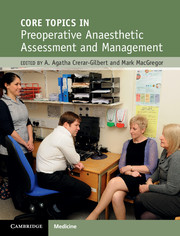
The ANZCA Clinical Fundamentals define the fundamental specialty knowledge and skills of anaesthetists applicable across all areas of practice.
They are: general anaesthesia and sedation; airway management; regional and local anaesthesia; perioperative medicine; pain medicine; resuscitation, trauma and crisis management; and safety and quality in anaesthetic practice.
Learn more about the resources to aid in developing knowledge and skills in these areas through training.
Guide index
 Library > Library guides > Training & examinations > Anaesthesia training resources
Library > Library guides > Training & examinations > Anaesthesia training resources
How to access e-resources
 Use your ANZCA college ID (or staff username) and password to access library e-resources.
Use your ANZCA college ID (or staff username) and password to access library e-resources.
 Having trouble logging into e-resources? Try emptying your browser cache, closing and reopening your browser, and trying again.
Having trouble logging into e-resources? Try emptying your browser cache, closing and reopening your browser, and trying again.
 Forgotten your ANZCA password? Try resetting your password using the "Forgot Password?" link and/or messaging the "Technical support" via the college contact form
Forgotten your ANZCA password? Try resetting your password using the "Forgot Password?" link and/or messaging the "Technical support" via the college contact form
 Want to learn more about SSO/MFA at ANZCA? See Protecting your data for more information, including instructions on how to set up MFA/SSO.
Want to learn more about SSO/MFA at ANZCA? See Protecting your data for more information, including instructions on how to set up MFA/SSO.
 Experiencing difficulties, or need help? Contact the Library
Experiencing difficulties, or need help? Contact the Library
Recommended resources are listed below.
 Additional perioperative medicine resources can be accessed via the Perioperative medicine guide.
Additional perioperative medicine resources can be accessed via the Perioperative medicine guide.
 Anesthesia and Perioperative Care of the High-Risk Patient, 3e
by
The fully updated third edition of this popular handbook provides a concise summary of perioperative management of high-risk surgical patients. Written by an international group of senior clinicians, chapters retain the practical nature of previous editions, with concise text in a bulleted format offering rapid access to key facts and advice.
Anesthesia and Perioperative Care of the High-Risk Patient, 3e
by
The fully updated third edition of this popular handbook provides a concise summary of perioperative management of high-risk surgical patients. Written by an international group of senior clinicians, chapters retain the practical nature of previous editions, with concise text in a bulleted format offering rapid access to key facts and advice.
 Core Topics in Preoperative Anaesthetic Assessment and Management
by
Part of the popular Core Topics series, this book provides a practical guide to pre-operative assessment for consultants and trainee anaesthetists. Chapters cover comprehensive evidence-based guidance for assessing and managing patients with particular conditions, as well as perioperative risk stratification and challenges of pre-assessment.
Core Topics in Preoperative Anaesthetic Assessment and Management
by
Part of the popular Core Topics series, this book provides a practical guide to pre-operative assessment for consultants and trainee anaesthetists. Chapters cover comprehensive evidence-based guidance for assessing and managing patients with particular conditions, as well as perioperative risk stratification and challenges of pre-assessment.
Interpretations of ECGs
Anatomy
 Anatomy for the FRCA
by
Anatomy questions are asked in all parts of the FRCA examinations, and for many trainees it is a particularly daunting part of the exams. This important new book provides a comprehensive, exam-orientated clinical anatomy book for anaesthetists preparing for all parts of the FRCA. It covers all body regions, relating underlying anatomy to practical procedures and anatomical principles, spanning the breadth of the curriculum and comprising exam-style questions: a chapter of SAQ questions, one of OSCE stations, one of SOE questions and one of MCQs. The text is highly illustrated in full colour with ultrasound images, diagrams and photographs of cadaveric material and models.
Anatomy for the FRCA
by
Anatomy questions are asked in all parts of the FRCA examinations, and for many trainees it is a particularly daunting part of the exams. This important new book provides a comprehensive, exam-orientated clinical anatomy book for anaesthetists preparing for all parts of the FRCA. It covers all body regions, relating underlying anatomy to practical procedures and anatomical principles, spanning the breadth of the curriculum and comprising exam-style questions: a chapter of SAQ questions, one of OSCE stations, one of SOE questions and one of MCQs. The text is highly illustrated in full colour with ultrasound images, diagrams and photographs of cadaveric material and models.
Biochemistry
Recommended POM risk calculator websites and articles are listed below.


Recommended UTD links are listed below. Note: Please access via your local hospital network. No access via ANZCA.
Recommended professional documents are listed below. The full suite of ANZCA professional documents can be accessed via the college page.
Recommended American Society of Anesthesiologists (ASA) guidelines are listed below. Additional ASA guidelines, statements ad clinical resources can be accessed via the ASA website.

SAMBA's PONV guidelines are listed below. Additional SAMBA resources can be accessed via the SAMBA Clinical Practice Guidelines page.

Choosing Wisely Australia resources for health professionals.



Quick links
About ANZCA
Copyright © Australian and New Zealand College of Anaesthetists.